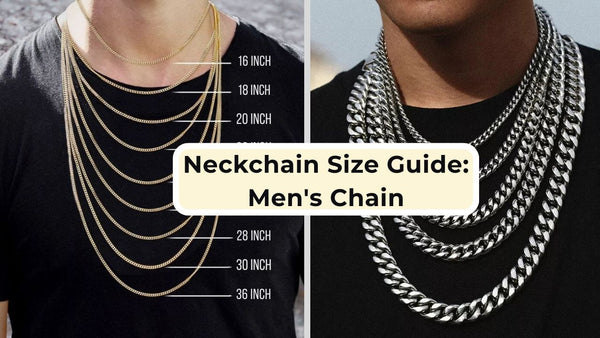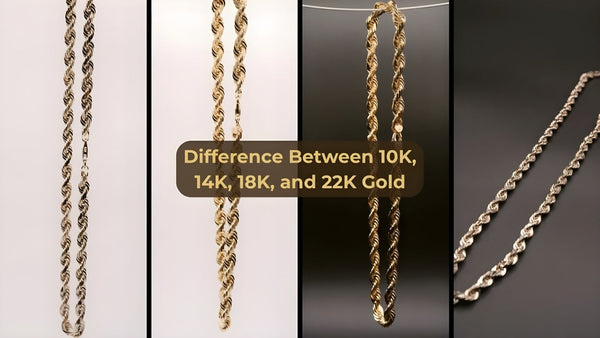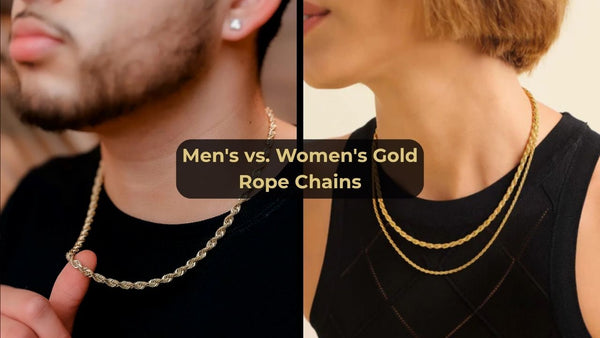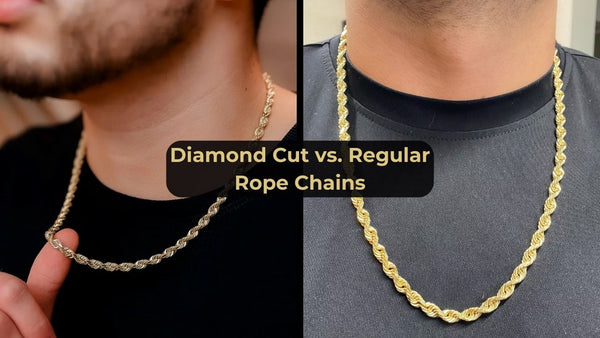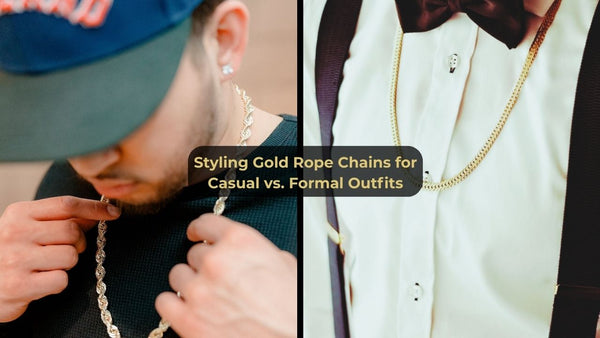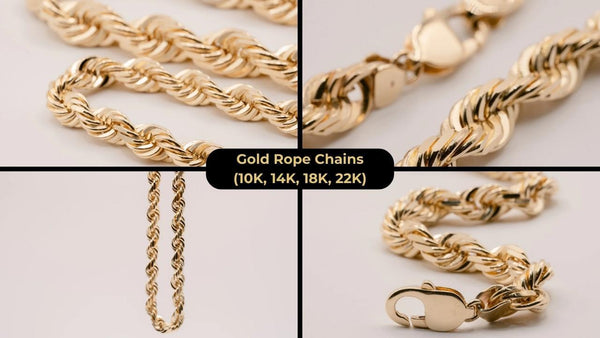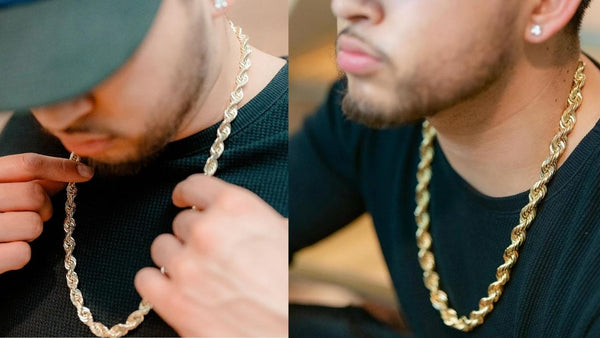Article at a Glance:
- Solid gold rope chains represent a sophisticated intersection of metallurgy and precision engineering, combining helical patterns with structural integrity
- Construction quality depends on critical factors like link proportions, pattern angles, weight distribution, and connection tolerances
- Different rope chain patterns (standard twist, diamond cut, heavy rope, multi-twist, semi-solid) each present unique manufacturing challenges and quality considerations
- Professional evaluation requires systematic analysis of structural integrity, surface engineering, and manufacturing precision
- Long-term durability relies on pattern-specific maintenance protocols and proper stress distribution engineering
Understanding the technical mastery behind rope chain construction helps collectors and enthusiasts make informed decisions about quality, authenticity, and value while ensuring proper maintenance of these precision-engineered pieces.
The mastery of solid gold rope chain construction lies in the precision engineering of interlocked metal links, twisted in helical patterns that create both structural integrity and visual sophistication.

For collectors and enthusiasts, these pieces represent significant technical achievement in metallurgy and manufacturing, combining traditional metalworking techniques with modern innovation.
Technical Foundation

When examining solid gold rope chains specifically, the foundational architecture depends on several key factors:
- Link size proportions
- Helical pattern angles
- Weight and tension distribution
- Connection tolerances
These technical parameters influence both structural performance and overall quality. The complexity of proper rope chain construction becomes apparent when examining the mechanical principles involved:
- Load Distribution: The helical structure helps disperse tensile forces across multiple contact points, contributing to structural integrity.
- Interface Dynamics: Each link must maintain appropriate contact geometry with adjacent links while allowing controlled movement.
- Stress Management: The pattern configuration needs to balance flexibility requirements with material stress limitations.
Historical Development and Manufacturing Evolution

The development of rope chain patterns has evolved alongside advances in metalworking technology. Early metalworkers discovered that helical metal structures could provide excellent strength-to-weight ratios compared to linear arrangements.
Early Period:
- Predominantly hand-forged links individually shaped and assembled
- Variable standardization in link geometries
- Quality heavily dependent on individual craftmanship
Industrial Period:
- Introduction of mechanical forming processes
- Progress toward standardized sizing
- Implementation of quality control measures
Contemporary Period:
- Integration of computer-aided design
- Advanced cutting systems
- Enhanced metallurgical controls
- Modern joining technologies
Current production methods have achieved significant improvements in important areas:
- Enhanced link tolerance control
- More consistent strength distribution
- Improved surface finishing
- Better joint durability
Pattern Engineering Classifications

Standard Twist Engineering
The foundational pattern typically employs multiple links arranged in a helical geometry with attention to:
- Pattern angle
- Link overlap proportions
- Rotational symmetry
- Surface contact between adjacent links
Manufacturing complexity tends to increase with smaller diameters, requiring careful tension control to maintain structural integrity while preserving movement.
Diamond Cut Technical Specifications
Diamond cut patterns introduce engineered facets requiring specialized manufacturing controls:
- Appropriate facet depth
- Consistent cutting angles
- Regular pattern spacing
- Quality surface finish
Critical manufacturing considerations include:
- Cutting tool pressure management
- Depth control
- Pattern alignment
- Surface hardness maintenance
Heavy Rope Engineering
Heavy rope patterns modify standard geometries through:
- Increased link density
- Enhanced contact surface area
- Modified pattern angles
- Reinforced link interfaces
These modifications create greater structural mass while demanding precise manufacturing controls to maintain proper articulation.
Multi-Twist Technical Architecture
Multi-twist patterns represent a highly complex manufacturing challenge:
- Primary helical pattern
- Secondary overlay pattern
- Complex angle calculations
- Stress distribution across multiple planes
Manufacturing challenges include:
- Maintaining consistent tension throughout layers
- Achieving proper alignment between elements
- Ensuring balanced load distribution
- Preventing pattern interference
Semi-Solid Engineering
Semi-solid construction employs specialized material distribution techniques:
- Strategic internal spacing
- Reinforced stress points
- Optimized strength ratios
- Enhanced surface stability
This engineering approach requires careful control of:
- Internal geometry
- Wall thickness variations
- Support structure placement
- Joint reinforcement
Technical Quality Assessment
Professional evaluation of solid gold rope chains requires systematic analysis of key engineering factors and manufacturing precision indicators.
Structural Analysis Parameters
Link Interface Examination:
- Joint integrity and surface contact quality
- Connection point distribution
- Interface alignment
- Stress point reinforcement
Surface Engineering Quality:
- Finish consistency across pattern transitions
- Micro-surface stability
- Pattern registration accuracy
- Material density distribution
Manufacturing Precision Indicators:
- Link size consistency
- Pattern spacing uniformity
- Surface finish quality
- Pattern depth consistency
Advanced Pattern-Specific Evaluation
Diamond Cut Assessment:
- Facet angle consistency
- Cut depth uniformity
- Pattern registration
- Surface hardness
- Edge definition
Multi-Twist Inspection:
- Layer alignment
- Pattern spacing
- Tension distribution
- Geometry stability
- Pattern intersection quality
Professional Maintenance Protocols
Diamond Cut Pattern Maintenance:
- Regular professional ultrasonic cleaning
- Use of appropriate pH-balanced cleaning solutions
- Proper brush selection and technique
- Careful pressure application
- Professional refinishing when needed
Multi-Twist Pattern Care:
- Specialized cleaning tools for reaching between layers
- Regular tension checks
- Link alignment inspections
- Professional cleaning protocols
- Ongoing stress point monitoring
Heavy Rope Maintenance:
- Appropriate pressure distribution during cleaning
- Regular stability checks
- Surface condition monitoring
- Professional realignment as needed
- Regular wear pattern analysis
Quality and Value Considerations
Technical Factors Affecting Quality
Manufacturing Assessment:
- Overall pattern engineering
- Production technique sophistication
- Quality control standards
- Technical execution proficiency
Quality Indicators:
- Link geometry consistency
- Joint durability
- Pattern uniformity
- Surface finish quality
- Material distribution
Pattern-Specific Considerations:
- Diamond Cut: Focus on faceting quality and pattern consistency
- Multi-Twist: Emphasis on layer alignment and structural integrity
- Heavy Rope: Attention to mass distribution and strength
- Semi-Solid: Assessment of engineering efficiency and structure
Manufacturing Considerations
Production Quality Factors:
- Facility technical capabilities
- Quality control implementation
- Manufacturing process standards
- Production documentation
Age-Related Considerations:
- Manufacturing period identification
- Production method assessment
- Historical context evaluation
Quality Authentication
Technical Documentation:
- Manufacturing process records
- Material composition details
- Structural testing information
- Quality control records
- Technical specifications
Authentication Elements:
- Detailed pattern analysis
- Manufacturing technique verification
- Material composition assessment
- Structural integrity evaluation
Conclusion
High-quality solid gold rope chains exemplify significant achievements in jewelry engineering and manufacturing precision. Their quality stems from the technical sophistication of their construction, the precision of their execution, and the consistency of their maintenance.
For collectors and enthusiasts, understanding these technical aspects proves valuable for:
- Making informed purchasing decisions
- Assessing quality accurately
- Maintaining collection condition
- Verifying authenticity
The market generally recognizes and rewards superior engineering and manufacturing quality in these pieces, though many factors beyond technical specifications influence value.
Frequently Asked Questions (FAQs)
Q: What indicates high quality in rope chain manufacturing?
A: High-quality pieces exhibit consistent link geometries, even pattern registration, and superior joint integrity. Manufacturing documentation should support these qualities through appropriate testing and verification.
Q: How does pattern complexity relate to quality?
A: While pattern complexity often requires more sophisticated manufacturing processes, execution quality remains paramount. A well-executed standard pattern may demonstrate higher quality than a poorly executed complex pattern.
Q: What factors most impact long-term durability?
A: Key considerations include:
- Link interface engineering
- Stress distribution
- Joint construction quality
- Material consistency
- Pattern maintenance
Q: How can collectors assess manufacturing quality?
A: Professional assessment typically includes:
- Detailed pattern analysis
- Surface quality evaluation
- Joint integrity checking
- Pattern consistency verification
- Documentation review
Q: What maintenance helps preserve quality?
A: Different patterns require specific maintenance approaches:
- Diamond Cut: Special cleaning methods preserving facets
- Multi-Twist: Layer-specific cleaning and maintenance
- Heavy Rope: Regular monitoring and alignment checks
- Semi-Solid: Structure and surface preservation
Frequently Unasked Questions (FUQs)
Q: How important are manufacturing facility capabilities?
A: Facility technical capabilities significantly influence production precision and consistency. Modern facilities with current equipment and strong quality controls typically produce higher quality pieces.
Q: What role does documentation play in authentication?
A: Comprehensive documentation provides important verification of manufacturing processes and technical specifications, helping establish piece authenticity.
Q: How does stress distribution affect wear patterns?
A: Effective stress distribution engineering influences wear characteristics and maintenance needs. Well-designed pieces typically maintain their structural integrity better over time.
Q: How does link geometry affect quality assessment?
A: Link geometry consistency serves as an important indicator of manufacturing quality. Superior consistency often reflects higher production standards.
Q: What impact might new manufacturing technologies have?
A: Advancing technologies, including precision joining methods and computer-aided design, continue to evolve. Understanding these developments helps anticipate potential impacts on future production standards.
Experience the Excellence of Solid Gold Rope Chains
At Rope Chain LA, we bring you expertly crafted solid gold rope chains that combine durability, timeless elegance, and versatility. Whether you’re seeking a standout statement piece or an everyday accessory, our chains are designed to deliver unmatched quality and sophistication.
Why Choose Rope Chain LA?
- Premium Quality: Available in 10K, 14K, and 18K gold in yellow, white, or rose finishes.
- Guaranteed Fast & Free Shipping: On all USA orders.
- Expert Craftsmanship: Every chain is engineered for strength, comfort, and flawless style.
Take the Next Step
Ready to elevate your jewelry collection? Browse our website to find the perfect solid gold rope chain for your style and needs. Explore our exclusive designs and discover why Rope Chain LA is a trusted name in jewelry craftsmanship.
💎 Follow us for inspiration and updates:
Don’t wait—experience the difference of superior quality and timeless beauty with Rope Chain LA.






